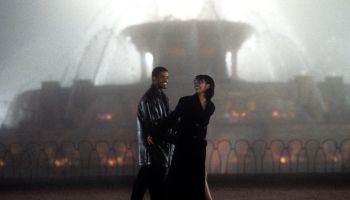Trump, North Korea Exchange Threats
Trump, North Korea Exchange Escalating Threats

SEOUL, South Korea (AP) — North Korea and the United States traded escalating threats, with President Donald Trump threatening Pyongyang “with fire and fury like the world has never seen” and the North’s military claiming Wednesday it was examining its plans for attacking Guam.
The comments follow reports that North Korea has mastered a crucial technology needed to strike the United States with a nuclear missile.
Despite regular North Korean threats against Guam, a U.S. territory in the Pacific about 2,100 miles (3,400 kilometers) from the Korean Peninsula, it is extremely unlikely that Pyongyang would risk the assured annihilation of its revered leadership with a pre-emptive attack on U.S. citizens.
Still, the competing threats and Trump’s use of North Korea-style rhetoric — Pyongyang has long vowed to reduce Seoul to a “sea of fire” — raise the already high animosity and heighten worries that a miscalculation might spark conflict between the nuclear-armed nations.
The North Korean army said in a statement distributed by the state-run news agency that it is studying a plan to create an “enveloping fire” in areas around Guam with medium- to long-range ballistic missiles. The statement described Andersen Air Force Base on Guam as a “beachhead” for a potential U.S. invasion of North Korea it needed to neutralize. It was unlikely the North’s threat was a direct response to Trump’s comments to the camera at his golf course in Bedminster, New Jersey.
South Korea’s Unification Ministry, which deals with matters related to North Korea, said the North’s army statement hurts efforts to improve inter-Korean relations. Ministry spokesman Baek Tai-hyun said Seoul remains committed to both dialogue and sanctions for solving the North Korean nuclear problem and called for Pyongyang to stop its provocations.
Trump spoke hours after reports were published that indicate North Korea can now wed nuclear warheads with its missiles, including its longest-range missiles that may be able to hit the American mainland. The North has strived for decades to have the ability to strike the U.S. and its Asian allies, and the pace of its breakthroughs is having far-reaching consequences for stability in the Pacific and beyond.
The nuclear advances were detailed in an official Japanese assessment Tuesday and a later Washington Post story that cited U.S. intelligence officials and a confidential Defense Intelligence Agency report. The U.S. now assesses the North Korean arsenal at up to 60 nuclear weapons, more than double most assessments by independent experts, according to the Post’s reporting.
“North Korea had best not make any more threats to the United States,” said a stern-looking Trump, seated with his arms crossed and with his wife beside him. “They will be met with fire and fury like the world has never seen.”
“He has been very threatening beyond a normal state. And as I said they will be met with fire, fury and frankly power the likes of which this world has never seen before.”
The remarks appeared scripted, with Trump glancing at a paper in front of him. They evoked President Harry Truman’s announcement of the U.S. atomic bomb dropped on Hiroshima, Japan, in 1945, in which he warned of “a rain of ruin from the air, the like of which has never been seen on this earth.”
But it wasn’t clear what Trump, who is prone to hyperbole and bombast in far less grave situations, meant by the threat. White House officials did not elaborate.
Senate Democratic Leader Chuck Schumer issued a statement afterward saying, “We need to be firm and deliberate with North Korea, but reckless rhetoric is not a strategy to keep America safe.”
The Trump administration considers North Korea to be America’s greatest national security threat and tensions have steadily escalated this year.
Pyongyang responded angrily to the U.N. Security Council’s adoption this weekend of new, tougher sanctions spearheaded by Washington. The sanctions followed intercontinental ballistic missile tests last month, the second of which was estimating as having a range that could reach more of the U.S. mainland. The newly revealed U.S. intelligence assessment indicates those missiles can carry nuclear warheads.
Denouncing the U.N. sanctions through state media, the North warned: “We will make the U.S. pay by a thousand-fold for all the heinous crimes it commits against the state and people of this country.”
For North Korea, having a nuclear-tipped missile that could strike America would be the ultimate guarantee against U.S. invasion.
It is an ambition decades in the making. North Korea began producing fissile material for bombs in the early 1990s and conducted its first nuclear test explosion in 2006. Four subsequent nuclear tests, the latest a year ago, have accelerated progress on miniaturizing a device — something North Korea already claimed it could do. Over that span, multiple U.S. presidents have tried and failed to coax or pressure Pyongyang into abandoning its nuclear ambitions.
The secrecy of the North’s nuclear program and the underground nature of its test explosions make it very difficult to properly assess its claims. But the new assessments from Japan and the U.S. suggest that doubts over the North’s abilities are receding.
In an annual report, Japan’s Defense Ministry on Tuesday concluded that “it is possible that North Korea has achieved the miniaturization of nuclear weapons and has developed nuclear warheads.” Japan, a key U.S. ally, is a potential, front-line target of North Korean aggression.
The Post story, citing unnamed U.S. intelligence officials, went further. It said the Defense Intelligence Agency analysis, completed last month, assessed North Korea has produced nuclear weapons for ballistic missile delivery, including by intercontinental missiles.
Officials at the agency wouldn’t comment Tuesday. The Office of the Director of National Intelligence also wouldn’t discuss the report.
It’s unclear how North Korea’s new capabilities will immediately affect how the U.S. approaches the country’s regular missile launches and occasional nuclear tests. The U.S. military has never attempted to shoot a North Korean missile out of the sky, deeming all previous tests to pose no threat to the United States. The U.S. could weigh military action if the threat perception changes.
The calculation of North Korea’s nuclear arsenal at 60 bombs exceeds other assessments, which range from around one dozen to about 30 weapons. The assessments are typically an estimate of the amount of plutonium and enriched uranium North Korea has in its inventory rather than how much of that material has been weaponized. It’s unclear how many, if any, miniaturized warheads North Korea has built.
Last month’s ICBM tests highlighted the growing threat. Both missiles were fired at highly lofted angles and landed at sea near Japan, but analysts said the weapons could reach Alaska, Los Angeles or Chicago if fired at a normal, flattened trajectory.
North Korea threatened to hit Guam with its Hwasong-12 missiles, which it says can carry a heavy nuclear warhead and before the two ICBM launches had demonstrated the longest potential range of the missiles test-fired by the North.
Not all technical hurdles have been overcome, however. North Korea is still believed to lack expertise to ensure a missile could re-enter the Earth’s atmosphere without the warhead burning up. And it’s still working on striking targets with accuracy.
___
Pennington reported from Washington. Hyung-jin Kim in Seoul, Deb Riechmann in Washington and Catherine Lucey in New Jersey contributed to this report.
PHOTO: AP
Like BlackAmericaWeb.com on Facebook. Follow us on Twitter and Instagram
Share your email below to receive our daily newsletter!















